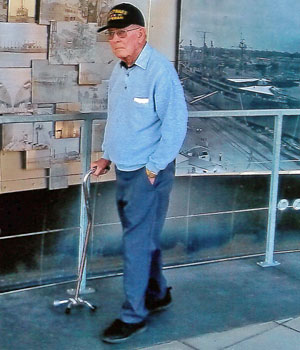January 31, 2017 • Headline News
Pick up a copy of the newspaper your local newsstand.

UPDATED BY MARIA SIEVERDING JANUARY 31, 2017 1 P.M.
WWII veteran humbled by museum visit
By Sandy Day Howard
CONTRIBUTING WRITER
A maritime memorial to the women and men who served our country stretches along Charleston Harbor in South Carolina. The centerpiece of the several acre display is the USS Yorktown, an aircraft carrier that was named after the Battle of Yorktown during the Revolutionary War.
Patriots Point Naval & Maritime Museum is located in Mount Pleasant, South Carolina, at the mouth of the Cooper River directly on the harbor. Although primarily dedicated to Naval veterans, Patriots Point recounts a story of victories and defeats; of conflicts large and small and is a tribute to all those who fought for their country and to the ones who gave all for the cause of freedom throughout American history.
 SUBMITTED PHOTO
SUBMITTED PHOTO
Bob Day said while touring the museum people approached him and thanked him for his service. “It brought tears to my eyes.”
Bob Day of Osgood served in the United States Army for 38 months during World War II. At that time, Day was stationed in Aliceville, Alabama where over 600,000 prisoners of war were held. Japanese, Italian, and German soldiers, captured during the conflict, were shipped to prisons throughout the world with over 600 thousand of those being held in a variety of US locations. Part of Day’s service during that time of war remains confidential but his primary role during his three years centered around the German POWs.
“I had the pleasure of visiting the memorial while I was in South Carolina with my friends, Mr and Mrs. Tom Grubbs.” Day stated. “I enjoyed it because it was military.”
While visiting Patriot’s Point, Day boarded the USS Yorktown which is home to several exhibits, including the nation’s Medal of Honor Museum. Also aboard are 25 naval aircraft including the A-4 Skyhawk, F-9 Cougar, and the F 14 Tomcat. Planes are visible on the flight deck and hangars contain a mixture of Gulf War, WWII, Korean War, and Vietnam War aircraft. Other marine vehicles available for tour are a destroyer vessel and the USS Clagamore, the only known surviving example of a ‘GUPPY’ type submarine that was built near the end of World War I.
“While we were going through the exhibits there, people were approaching me and thanking me for my service. Some of them were young kids who had no idea what WWII involved. It brought tears to my eyes.”
Onshore, visitors can view civil war era weapons, the PBR River Patrol Boat, and a naval support camp. Patriots Point also hosts military reenactments and weapons demonstrations and a variety of celebrations on patriotic holidays. The Cold War Memorial, the Congressional Medal of Honor Society Exhibit, and the only Vietnam Experience Exhibit in the US also make their home at Patriots Point. The two and a half acre Vietnam Experience features the MK1 River Patrol Boat floating in a landscaped tropical lagoon that can be boarded by visitors as well as a mess hall reminiscent of those erected for Vietnam era servicemen and women. An observation tower, the 105 Howitzer gun, and three different types of aircraft are also on display and offer a ‘hands on’ experience.
“The most significant part of the memorial for me was the stone walkway with names of soldiers of the Confederacy who had died during the Civil War,” recounted the former corporal. “The names were etched in the stones. It was very humbling.”
Day, now 94, was also honored last year to have been selected to be part of an “Honor Flight” where he was flown to Washington DC along with 200 other veterans to tour the WWII Memorial, Lincoln Memorial, and other commemorative sites in our nation’s capital. While there, the entourage was accompanied by a police escort throughout the city. Day was enamored with the public shows of patriotism as well as by visitors who thanked the honorees for their service as he visited both memorial sites.
For more information on the museum, go to www.patriotspoint.org.
A Democracy’s Primer: The role of the judiciary
By Bonnie C. Coleman
In 1787, the 12 states adopted the Constitution of the United States of America. In the Constitution, there are three branches of government. By having three branches of government, checks and balances exist so that one branch won’t be more powerful than another.
First branch of government: Legislative
The first branch is the legislative branch, which provides that representatives and senators elected by citizens from each state make the laws. When laws are passed and put in writing they are called statutes.
Second branch of government: Executive
The second is the executive branch which provides for an elected president and vice president. The president is in charge of the military, appoints judges and carries out the laws.
Third branch of government: Judicial
The third branch is the judicial branch. Judges decide how laws apply to particular situations, settle disputes and determine if laws are violated. There are federal courts and state courts. The president appoints federal judges and the appointments must be confirmed by the Senate. Federal judges usually decide cases regarding federal laws and federal crimes.
State Laws and Constitutions
The states also have state laws and constitutions which provide for three branches of government. In state courts, some judges are appointed and some judges are elected. State court judges usually decide cases dealing with state laws and state crimes. A judge needs to know the statutes that are adopted by the legislative branch. The judge also studies prior orders and decisions made by judges in other cases. When a judge considers prior decisions, the judge is considering precedent. The judge hears the facts from the parties, considers statutes and precedent, and makes a decision. Judges put their decisions in written orders or judgments. When an order or judgment is signed by a judge, usually a party has the right to appeal. That means a person who doesn’t like the order or judgment can ask another higher court, usually consisting of a group of judges, to reconsider the decision or order.
The U.S. Supreme Court
The highest court in the land is the U.S. Supreme Court. When there are no vacancies on the court, there are nine U.S. Supreme Court judges who decide cases and the majority rules. Supreme Court decisions are very important. The Constitution gives the judicial branch certain powers to limit acts of the other branches, which is part of the checks and balances that exist between the three branches of government.
Early in the history of this country, the Supreme Court ruled that it had the power to declare a law to be unconstitutional. In 1803, President John Adams had nominated several justices of the peace. The Senate confirmed the nominations; and the papers appointing the justices, known as commissions, were signed. Some of the commissions were not delivered before President Thomas Jefferson took office. Jefferson would not allow his secretary of state to deliver the commissions. William Marbury, a man whose commission was not delivered, petitioned the Supreme Court seeking an order requiring delivery. The Supreme Court said that the commissions were valid and Marbury was entitled to delivery; however, the act giving the court the right to issue the order was unconstitutional because it violated Article III of the Constitution. Therefore, Marbury was not given the order he requested. This early ruling established the right of the judiciary to limit the legislative branch from passing laws in violation of the Constitution.
The Supreme Court has also exercised its power over the executive branch. In 1974, following the scandal known as Watergate, a special prosecutor issued a subpoena to President Richard Nixon to turn over tapes of conversations that took place in the oval office. The president refused and the dispute came before the Supreme Court. The president argued that he was entitled to executive privilege; so, the Court couldn’t force him to turn over the tapes. The Supreme Court unanimously ruled that there were situations where executive privilege did not apply. The president was ordered to turn over the tapes. A short time later, Nixon resigned from office.
Rulings of the Supreme Court can change the way things happen in our country. Each of the three branches of government is given certain powers over the other branches. The Supreme Court has exercised this power over both the legislative and the executive branch.
Bonnie C. Coleman is a Merrillville, Indiana, attorney and a volunteer for the Indiana Bar Foundation.
Editors Note: A Democracy’s Primer is a collaboration between the journalism and legal communities to aid the public’s understanding of how government works with citizen engagement. Volunteers for the Indiana Bar Foundation (Bar Foundation) will write the articles for distribution by the Hoosier State Press Association Foundation. More about the both organizations may be found at www.inbf.org/ and http://www.hspafoundation.org/.
UPDATED BY MARIA SIEVERDING JANUARY 31, 2017 1 P.M.
WWII veteran humbled by museum visit
By Sandy Day Howard
CONTRIBUTING WRITER
A maritime memorial to the women and men who served our country stretches along Charleston Harbor in South Carolina. The centerpiece of the several acre display is the USS Yorktown, an aircraft carrier that was named after the Battle of Yorktown during the Revolutionary War.
Patriots Point Naval & Maritime Museum is located in Mount Pleasant, South Carolina, at the mouth of the Cooper River directly on the harbor. Although primarily dedicated to Naval veterans, Patriots Point recounts a story of victories and defeats; of conflicts large and small and is a tribute to all those who fought for their country and to the ones who gave all for the cause of freedom throughout American history.
 SUBMITTED PHOTO
SUBMITTED PHOTOBob Day said while touring the museum people approached him and thanked him for his service. “It brought tears to my eyes.”
Bob Day of Osgood served in the United States Army for 38 months during World War II. At that time, Day was stationed in Aliceville, Alabama where over 600,000 prisoners of war were held. Japanese, Italian, and German soldiers, captured during the conflict, were shipped to prisons throughout the world with over 600 thousand of those being held in a variety of US locations. Part of Day’s service during that time of war remains confidential but his primary role during his three years centered around the German POWs.
“I had the pleasure of visiting the memorial while I was in South Carolina with my friends, Mr and Mrs. Tom Grubbs.” Day stated. “I enjoyed it because it was military.”
While visiting Patriot’s Point, Day boarded the USS Yorktown which is home to several exhibits, including the nation’s Medal of Honor Museum. Also aboard are 25 naval aircraft including the A-4 Skyhawk, F-9 Cougar, and the F 14 Tomcat. Planes are visible on the flight deck and hangars contain a mixture of Gulf War, WWII, Korean War, and Vietnam War aircraft. Other marine vehicles available for tour are a destroyer vessel and the USS Clagamore, the only known surviving example of a ‘GUPPY’ type submarine that was built near the end of World War I.
“While we were going through the exhibits there, people were approaching me and thanking me for my service. Some of them were young kids who had no idea what WWII involved. It brought tears to my eyes.”
Onshore, visitors can view civil war era weapons, the PBR River Patrol Boat, and a naval support camp. Patriots Point also hosts military reenactments and weapons demonstrations and a variety of celebrations on patriotic holidays. The Cold War Memorial, the Congressional Medal of Honor Society Exhibit, and the only Vietnam Experience Exhibit in the US also make their home at Patriots Point. The two and a half acre Vietnam Experience features the MK1 River Patrol Boat floating in a landscaped tropical lagoon that can be boarded by visitors as well as a mess hall reminiscent of those erected for Vietnam era servicemen and women. An observation tower, the 105 Howitzer gun, and three different types of aircraft are also on display and offer a ‘hands on’ experience.
“The most significant part of the memorial for me was the stone walkway with names of soldiers of the Confederacy who had died during the Civil War,” recounted the former corporal. “The names were etched in the stones. It was very humbling.”
Day, now 94, was also honored last year to have been selected to be part of an “Honor Flight” where he was flown to Washington DC along with 200 other veterans to tour the WWII Memorial, Lincoln Memorial, and other commemorative sites in our nation’s capital. While there, the entourage was accompanied by a police escort throughout the city. Day was enamored with the public shows of patriotism as well as by visitors who thanked the honorees for their service as he visited both memorial sites.
For more information on the museum, go to www.patriotspoint.org.
A Democracy’s Primer: The role of the judiciary
By Bonnie C. Coleman
In 1787, the 12 states adopted the Constitution of the United States of America. In the Constitution, there are three branches of government. By having three branches of government, checks and balances exist so that one branch won’t be more powerful than another.
First branch of government: Legislative
The first branch is the legislative branch, which provides that representatives and senators elected by citizens from each state make the laws. When laws are passed and put in writing they are called statutes.
Second branch of government: Executive
The second is the executive branch which provides for an elected president and vice president. The president is in charge of the military, appoints judges and carries out the laws.
Third branch of government: Judicial
The third branch is the judicial branch. Judges decide how laws apply to particular situations, settle disputes and determine if laws are violated. There are federal courts and state courts. The president appoints federal judges and the appointments must be confirmed by the Senate. Federal judges usually decide cases regarding federal laws and federal crimes.
State Laws and Constitutions
The states also have state laws and constitutions which provide for three branches of government. In state courts, some judges are appointed and some judges are elected. State court judges usually decide cases dealing with state laws and state crimes. A judge needs to know the statutes that are adopted by the legislative branch. The judge also studies prior orders and decisions made by judges in other cases. When a judge considers prior decisions, the judge is considering precedent. The judge hears the facts from the parties, considers statutes and precedent, and makes a decision. Judges put their decisions in written orders or judgments. When an order or judgment is signed by a judge, usually a party has the right to appeal. That means a person who doesn’t like the order or judgment can ask another higher court, usually consisting of a group of judges, to reconsider the decision or order.
The U.S. Supreme Court
The highest court in the land is the U.S. Supreme Court. When there are no vacancies on the court, there are nine U.S. Supreme Court judges who decide cases and the majority rules. Supreme Court decisions are very important. The Constitution gives the judicial branch certain powers to limit acts of the other branches, which is part of the checks and balances that exist between the three branches of government.
Early in the history of this country, the Supreme Court ruled that it had the power to declare a law to be unconstitutional. In 1803, President John Adams had nominated several justices of the peace. The Senate confirmed the nominations; and the papers appointing the justices, known as commissions, were signed. Some of the commissions were not delivered before President Thomas Jefferson took office. Jefferson would not allow his secretary of state to deliver the commissions. William Marbury, a man whose commission was not delivered, petitioned the Supreme Court seeking an order requiring delivery. The Supreme Court said that the commissions were valid and Marbury was entitled to delivery; however, the act giving the court the right to issue the order was unconstitutional because it violated Article III of the Constitution. Therefore, Marbury was not given the order he requested. This early ruling established the right of the judiciary to limit the legislative branch from passing laws in violation of the Constitution.
The Supreme Court has also exercised its power over the executive branch. In 1974, following the scandal known as Watergate, a special prosecutor issued a subpoena to President Richard Nixon to turn over tapes of conversations that took place in the oval office. The president refused and the dispute came before the Supreme Court. The president argued that he was entitled to executive privilege; so, the Court couldn’t force him to turn over the tapes. The Supreme Court unanimously ruled that there were situations where executive privilege did not apply. The president was ordered to turn over the tapes. A short time later, Nixon resigned from office.
Rulings of the Supreme Court can change the way things happen in our country. Each of the three branches of government is given certain powers over the other branches. The Supreme Court has exercised this power over both the legislative and the executive branch.
Bonnie C. Coleman is a Merrillville, Indiana, attorney and a volunteer for the Indiana Bar Foundation.
Editors Note: A Democracy’s Primer is a collaboration between the journalism and legal communities to aid the public’s understanding of how government works with citizen engagement. Volunteers for the Indiana Bar Foundation (Bar Foundation) will write the articles for distribution by the Hoosier State Press Association Foundation. More about the both organizations may be found at www.inbf.org/ and http://www.hspafoundation.org/.














